
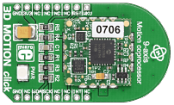
|
3D Motion click (Accel, Gyro, Mag, Fusion) Released

3D Motion click carries Microchip’s MM7150 9-axis sensor fusion motion module. It's a complete self contained solution comprising a 3-axis accelerometer, a gyroscope, a magnetometer, and a SSC7150 motion coprocessor. The motion coprocessor has sensor fusion alghoritms that take raw data from individual sensors and filter, compensate and combine them together. The resulting output provides reliable and accurate positioning and orientation information. The board communicates with the target MCU through the mikroBUS I2C interface; WAKE and RESET pins are also used (in placed of default mikroBUS AN and RST respectively), as well as an interrupt pin (INT).
|
2015/08/14 |

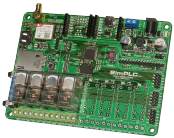
|
SimPLCv2 on Full Release

Now that the User Manual for the SimPLCv2 is complete, it is now on full release status.
|
2015/08/03 |

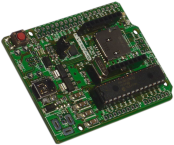
|
Breeze A Updated

Our Breeze Type A boards have been updated with some prettier silkscreen, a newer USB-UART module and larger solder pads. We also snapped some pics to indicate how versatile the Breeze boards are (some of the many ways in which they can be used) - check them out on the product page.
|
2015/08/03 |

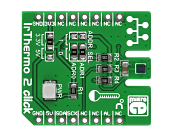
|
IrThermo2 click Released

IrThermo 2 click is a non-contact temperature measurement solution. The click board carries the TMP007 infrared thermopile sensor with an integrated math engine. The sensor absorbs the infrared radiation emitted by the target object (within the sensor's field of view) and the integrated math engine calculates its temperature by comparing it with the temperature of the silicon die. The measurement range of the sensor is between -40°C to 125°C (with a 14-bit resolution). The board is designed to use either a 3.3V or a 5V power supply.
|
2015/08/02 |

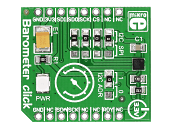
|
Barometer click (Pressure) Released

Barometer click carries the LPS25HB IC, which is a piezoresistive absolute pressure sensor with a measurement range from 260 to 1260 hPa (with a 24-bit resolution output). It's a high precision sensor and high resolution mode it can measure pressure within 0.01 hPa RMS. A low resolution mode can be implemented to reduce power consumption. Barometer click can communicate with the target board MCU either through I2C or SPI pins (which is specified by soldering onboard jumpers in appropriate position). An interrupt pin is also available, which can be configured either as Data Ready (sends signal when pressure value changes) or as a threshold trigger (sends signal when specified high or low pressure value is reached). The board uses a 3.3V power supply only.
|
2015/08/02 |

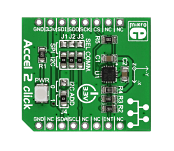
|
Accel 2 click (Accelerometer) Released

Accel 2 click carries ST's LIS3DSH IC, a low-power factory-calibrated three-axis accelerometer which embeds a FIFO buffer and two programmable state machines. It allows you to implement gesture recognition. User-defined programs can distinguish movement patterns like shake and double shake, face up and face down, turn and double turn, and activate an interrupt upon their execution. You can also switch between I2C and SPI interfaces for communicating with the target board MCU (by soldering the onboard jumpers in the appropriate positions). Accel 2 click is designed to use a 3.3V power supply only.
|
2015/07/30 |

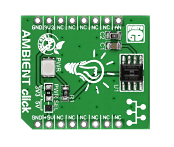
|
Ambient click Released

Ambient click carries the Melexis MLX75305 IC. It's a CMOS integrated optical sensor that consists of a photodiode, a transimpendance amplifier, and an output transistor. The chip converts ambient light intensity into a voltage, using the mikroBUS AN pin for communicating with the target board MCU. The board is designed to use either a 3.3V or a 5V power supply.
|
2015/07/30 |


|
4x4 Key click Released

4x4 Key click carries a 16 button keypad. The design of the board - inputs are read by a pair of connected 8-bit parallel-in serial-out shift registers - allows for multiple key presses at the same time. For ease of use, each button has silkscreen markings. The right-most column is marked with letters A-D, the other 12 buttons are marked like a telephone keypad. The board is designed to use either a 3.3V or 5V power supply.
|
2015/07/30 |

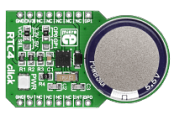
|
RTC4 click Released

RTC4 click carries DS2417, a real time clock/calendar with a 1-Wire MicroLAN interface and a programmable interrupt for system output. The clock frequency is derived from an onboard 32.768KHz oscillator. An integrated backup energy source maintains a charge with an onboard coin cell supercapacitor. The clock has an accuracy of +/-2 minutes per month at a 25 degrees Celsius temperature. Depending on the position of the onboard jumper, RTC4 click communicates with the target board MCU either through mikroBUS AN or PWM pin (here, GPI01, GPIO0), plus the INT pin. The board is designed to use either a 3.3V or 5V power supply.
|
2015/07/30 |

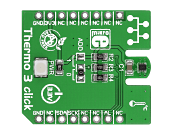
|
Thermo3 click Released

Thermo 3 click carries TMP102, a digital temperature sensor IC with a tiny footprint of only 1.6mm x 1.6mm.. Without requiring calibration, TMP102 is accurate within 0.5°C. Measurement range is between -25°C to 85°C. An integrated 12-bit ADC allows for measurement resolutions down to 0.0625°C. Thermo 3 click communicates with the target board MCU through mikroBUS I2C pins (SCL, SDA), and an additional Alert pint (INT on the default mikroBUS configuration). The board is designed to use a 3.3V power supply only.
|
2015/07/20 |

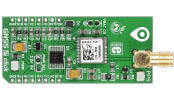
|
GNSS2 click Released

GNSS2 click carries Quectel's L76 module and an SMA antenna connector. GNSS stands for Global Navigation Satellite System, an umbrella term that describes both the United States GPS and the Russian GLONASS global positioning systems. The L76 module integrates performance-enhancing Quectel technologies. It can automatically predict satellite orbits from data stored in its internal flash (EASY technology) and it can adaptively adjust its on/off time to balance between positioning accuracy and power consumption (AlwaysLocate technology). GNSS2 click also features a voltage translator. Using the onboard jumper you can switch both the power supply and logic levels from 3.3V to 5V.
|
2015/07/20 |

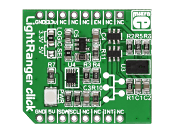
|
LightRanger click Released

LightRanger click is a proximity sensor carrying ST's VL6180X IC. This chip is based on ST's patented FlightSense technology: the sensor - consisting of an IR emitter, ambient light sensor, and range sensor - calculates distance by measuring the time it takes for a photon to travel to the nearest object and back (Time of Flight). In contrast to conventional IR proximity sensors which derive distance by measuring the amount of light reflected, VL618OX works with all objects, regardless of their color or reflectivity. LightRanger click communicates with the target board MCU through mikroBUS I2C pins (SCL, SDA), with additional interrupt (INT) and enable (EN, in place of default mikroBUS CS pin).
|
2015/07/20 |

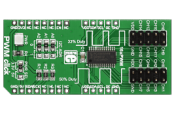
|
PWM click Released

PWM click is a simple solution for controlling 16 PWM outputs through a single I2C interface. You can use it to control anything from a simple LED strip to a complex robot with a multitude of moving parts. The click board carries the PCA9685PW IC. The board has an additional set of pins that allow you to connect up to seven PWM clicks together (using three jumpers to specify a different I2C address for each one). This will allow you to get a total of 112 pwm outputs on a single I2C line. PWM click is designed to use either a 3.3V or 5V power supply.
|
2015/07/20 |

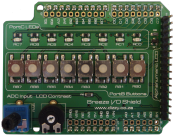
|
Breeze I/O Shield Released

The Breeze I/O Shield adds 8 LEDs*, 8 Buttons, an LCD connector and a potentiometer for analogue input to the Breeze board.
*On the Breeze B, only 6 LEDs are available (or 4 if a secondary crystal oscillator is connected). On the Breeze A, all LEDs are available.
|
2015/07/07 |

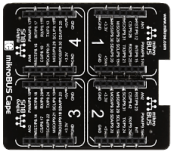
|
mikroBUS Cape Released

The mikroBUS cape is an extension for Beaglebone Black, the popular low-cost development platform running Linux. This simple cape has four mikroBUS sockets that allow you to connect more than 130 different types of click boards to BeagleBone. Quickly add functionalities like GSM, GPS, WiFi, ZigBee, Bluetooth, or thunder detection, proximity and color sensing, Hall current detection, speech recognition and many many more. To fully utilize Beaglebone's pinout, two additional sets of jumpers allow you to firstly switch the AN pins to GPIO on each mikroBUS socket, and secondly, choose whether to enable UART pins on the first socket or SPI pins on the third socket.
|
2015/07/07 |

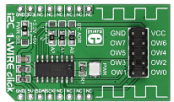
|
I2C 1 Wire click Released

I2C 1-Wire click carries DS2482, a "bridge device" that performs bidirectional conversions between I2C masters and 1-Wire slave devices. These can be EEPROM chips, temperature sensors and similar devices that have momentary high source current modes. I2C 1-Wire click enables any host with I2C to generate properly timed 1-Wire waveforms to its slave devices. The I2C interface (mikroBUS™ SCL and SDA pins) supports both standard I2C (100kHz max) and fast (400kHz) communication speeds. In addition to the mikroBUS socket, I2C 1-Wire click has an 8-channel pinout (each pin an independently operated 1-Wire I/O). The board is designed to use either a 3.3V or 5V power supply.
|
2015/07/06 |

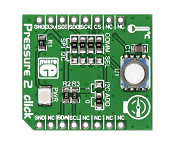
|
Pressure 2 click Released

Pressure 2 click carries an MS5803, a high resolution MEMS pressure sensor that is both precise and robust. Its measurement range is from 0 to 14 bars (with a resolution of up to 0.2 mbars), but because of the stainless steel cap enclosure, the sensor can withstand up to 30 bars of pressure. Pressure 2 click communicates with the target board MCU either through mikroBUS SPI or I2C lines, depending on the position in which the onboard jumpers are soldered.
|
2015/06/23 |


|
IR Reflect click Released

IR reflect click carries a GP2S700HCP reflective photointerrupter and an onboard potentiometer. On this type of photointerrupter the infrared emitter and receiver are facing the same direction; the infrared beam from the emitter gets bounced back to the receiver when an object is placed within the detecting range of the sensor. IR reflect click communicates with the target board microcontroller through mikroBUS AN and INT pins (an onboard potentiometer sets the Interrupt threshold). It’s designed to use either a 3.3V or 5V power supply.
|
2015/06/19 |

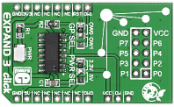
|
Expand3 click Released

EXPAND 3 click carries DS2408, an 8-channel programmable I/O expander that communicates with the target board MCU through a standard Dallas Semiconductor 1-Wire interface (15.3 kbps or 100kbps). The chip also has a factory-lasered 64-bit registration number, which enables multiple EXPAND 3 clicks to be connected on the same data line. For this purpose, the click has additional three pins above the mikroBUS socket. As for the socket, the onboard GP SEL jumper allows you to specify the communication pins (either OW1 or OW0, which are in place of the usual AN and PWM pins on mikroBUS). An additional reset line (RST) is also connected. The board is designed to use either a 3.3V or 5V power supply.
|
2015/06/19 |

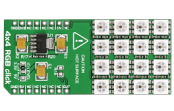
|
4X4 RGB click Released

4x4 RGB click carries a matrix of 16 WS2812 RGB LEDs and a MCP1826 low dropout regulator. These LEDs actually consist of three single colored LEDs (Red, Green and Blue), plus a control chip in a single package; various colors can be reproduced by mixing the intensity of each LED. However, don't drive the LEDs to maximum brightness because it will generate excessive heat and draw more current that advisable (up to 0.7A) which could potentially damage the mainboard. Also, don't touch the board when it's in use. The LED matrix is connected to the target board microcontroller through the mikroBUS RST pin. The board uses either a 3.3V or 5V power supply.
|
2015/06/15 |

|

